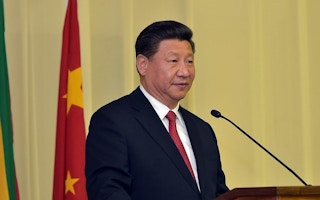China will strive to be carbon neutral by 2060 and strengthen its national climate pledge under the Paris Agreement, the country’s head of state said on Tuesday, marking the first time Chinese leadership has made a public commitment to net-zero emissions.
Speaking at a virtual United Nations General Assembly, President Xi Jinping also announced China’s ambition to peak carbon emissions before the end of this decade and called on world leaders to pursue a greener economic recovery from the coronavirus crisis.
“Humankind can no longer afford to ignore the repeated warnings of nature and go down the beaten path of extracting resources without investing in conservation, pursuing development at the expense of protection, and exploiting resources without restoration,” said Xi.
“China will scale up its Intended Nationally Determined Contributions (under the Paris Agreement) by adopting more vigorous policies and measures. We aim to have (carbon dioxide) emissions peak before 2030 and achieve carbon neutrality before 2060,” he said.
Xi’s remarks imply that China—the world’s biggest greenhouse gas emitter—plans to shoulder greater responsibility in the fight against global warming at a time that sees Covid-19 batter the world economy, climate action falter, and the United States formally withdraw from the Paris Agreement.
In his speech, however, Xi did not provide any further details on how China defines carbon neutrality, and no roadmap was offered as to how the necessary emissions cuts will be achieved.
China is currently responsible for about 28 per cent of global emissions and has drawn heavy criticism for being the world’s biggest public financier of coal-fired power projects.
Alex Whitworth, research director at research and consultancy firm Wood MacKenzie, said: “With this announcement, the world’s largest carbon emitter finally shifted from its long-term position of having limited responsibility to reduce global emissions as a developing country, to assuming clearer leadership in tackling climate change.”
Helen Mountford, vice president, climate and economics, at Washington-headquartered research organisation World Resources Institute, said: “This announcement will send positive shockwaves through diplomatic circles and should prompt greater climate ambition from other major emitters.”
“The case for ambitious climate action is stronger than ever and can deliver a strong economic recovery from Covid-19. Bold climate policy measures can grow China’s economy, create jobs and position the country well to compete and lead in a low-carbon 21st-century economy,” she said.
China’s vow comes on the heels of a proposal submitted by the European Union to strengthen the bloc’s climate commitments and cut emissions by at least 55 per cent by 2030.
In the United States, Joe Biden, the Democratic presidential candidate in the upcoming presidential elections, has pledged to rejoin the Paris climate deal and to steer the country—the world’s second-largest polluter—toward a low-emissions future.
Transforming China’s carbon emissions trajectory over the coming four decades will be a monumental task that will require tremendous investments and a radical overhaul of the world’s second-largest economy. According to new estimates, the nation would need to spend US$180 billion on green technologies and carbon capture processes annually to reach net-zero emissions by mid-century.
The upcoming 14th five-year plan, which will set the direction of China’s economy for the period of 2021 to 2025, will play a critical role in this transformation.
China’s new pledge suggests the blueprint, due to be published in March, will feature increased investment in wind, solar, electric vehicles and battery storage as well as support for green hydrogen and carbon capture technology, said Wood MacKenzie’s Asia Pacific vice-chair Gavin Thompson. But it will also likely maintain strong support for coal.
China’s energy sector has been moving in a new direction in recent years, with policies placing emphasis on electrification, natural gas and more efficient technologies. The International Energy Agency forecasts the country will overtake the European Union to become the world leader in installed solar photovoltaic capacity by 2021 and account for 40 per cent of total renewable capacity expansion between 2019 and 2024.
But coal demand and production capacity in the nation remain high. At present, out of every four tons of coal consumed around the world, one is burned to generate electricity in China. As of March 2020, the fossil fuel made up 64 per cent of the country’s electricity mix, with renewables accounting for 28 per cent.
China’s pledge comes as a new report warns that its post-pandemic recovery is slowing the nation’s energy transition, with policymakers stimulating carbon-heavy industry, and pushing for increased infrastructure development to jump-start the economy out of its coronavirus slump.
The analysis, by research company S&P Global Ratings, shows that total energy consumption of China’s economy in 2020 has risen by about 4 per cent relative to 2019. If current consumption patterns continue, they could disrupt a 15-year trend, during which the nation’s energy intensity dropped 42 per cent, warns the study.
The country has also eased curbs on thermal power plant development over the past three years and again in 2020. In the first half of 2020 alone, local authorities greenlighted about 19.7 gigawatts of new coal ventures, the biggest addition in the last five years.
Commenting on China’s statement, Shaun Roache, chief economist for Asia-Pacific at S&P Global Ratings, said: “The pledge provides a clear long-term destination for energy policy and the road to get there will start with next year’s five-year plan. To follow through on this commitment, we would need to see concrete policies that aim to reduce substantially the share of coal in the energy mix.”
Wood MacKenzie’s Thompson said: “China’s upcoming 14th five-year plan has the potential to be the most important document in global energy market history.”

















